Several temporary and travelling Talavera exhibits of certain themes have been created from these permanent collections. One of these was called “El Aguila en la Historia de Mexico” (The Eagle in the History of Mexico). The forty-two-piece exhibit was sponsored by the Senate of Mexico to show how the eagle symbol has been used in the country throughout its history. This exhibit was sponsored in honor of the Bicentennial of Independence in 2010. These ceramics were chosen because of their combination of art and utility. Eagles depicted include that of Mexico’s coat of arms, as well as those of political figures such as José María Morelos y Pavón and Porfirio Díaz, and those used by institutions such as the Royal and Pontifical University of Mexico and the Mexican Senate itself.
 Another exhibit in Mexico centered on the creation of maps using Talavera tile. Most tiles during the colonial period were decorated with flowers and landscapes but a significant number were painted to create murals with maps. Those that survive show how a number of cities developed over the colonial period. Eight of the most representative 16th-century Talavera tile maps were at the El Carmen Museum at an exhibit called “Cartografia: Una Vision en Talavera del Mexico Colonial” (Cartography: A Talavera Vision of Colonial Mexico). This exhibit was of reproductions of the originals created by the Talavera de la Luz workshop in Puebla. The chosen maps show the development of Mexico City as well as representations of the Acapulco, Puebla and the Tesuco regions during this time period.
Another exhibit in Mexico centered on the creation of maps using Talavera tile. Most tiles during the colonial period were decorated with flowers and landscapes but a significant number were painted to create murals with maps. Those that survive show how a number of cities developed over the colonial period. Eight of the most representative 16th-century Talavera tile maps were at the El Carmen Museum at an exhibit called “Cartografia: Una Vision en Talavera del Mexico Colonial” (Cartography: A Talavera Vision of Colonial Mexico). This exhibit was of reproductions of the originals created by the Talavera de la Luz workshop in Puebla. The chosen maps show the development of Mexico City as well as representations of the Acapulco, Puebla and the Tesuco regions during this time period.
Exhibits have been held outside of Mexico as well. The Museum of the Americas in Spain held an exhibit called “Talaveras de Puebla, Cerámica colonial Mexicana. Siglos XVII a XXI” (Talavera Pottery of Puebla, Mexican colonial ceramics, XVII to 21st centuries). This was a temporary exhibit of 49 pieces, combined with pieces from Spain and China as references. The pieces were loaned by the Franz Mayer Museum and the Bello Museum.
